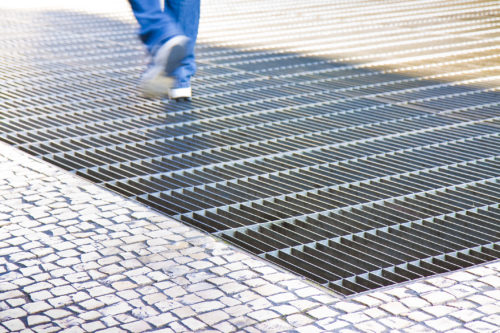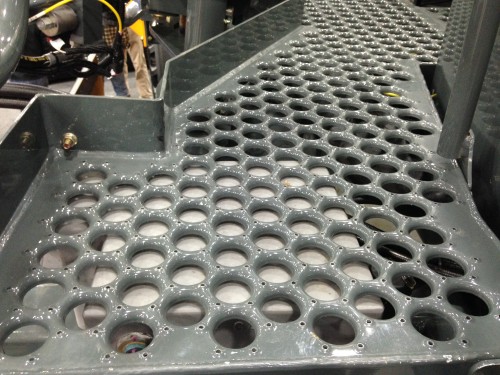Bar Grating vs. Safety Grating: What’s the Difference?
Comments Off on Bar Grating vs. Safety Grating: What’s the Difference?Workplace safety should be a top priority for any employer, but it’s most critical in industrial facilities where the risk of on-the-job injuries is at its peak. Slips, trips and falls are the #1 OSHA recordable instance. Slip and fall accidents cause about 15% of accidental workplace deaths, which highlights the importance of prioritizing safety in every element of a facility’s design, including seemingly harmless components like flooring.
Along with maintaining clean, dry passageways, selecting the appropriate type of grating for your industrial environment is a simple step that can mitigate the risk of such accidents. Safety grating addresses many of the design challenges of traditional bar grating to provide maximum protection to your workforce.
 Standard Bar Grating
Standard Bar GratingMetal bar grating has been a mainstay of industrial flooring for decades, consisting of welded steel arranged into a rectangular grid. This type of walkway is strong, versatile, and easy to maintain, making it a popular first choice for many in the industrial design arena.
Common Applications
Bar grating is a popular choice for a variety of applications. It is commonly used in:
- Bridge Flooring
- Trench Covers
- Walkways
- Ramps
- Platforms
- Catwalks
- Mezzanines
 Safety Grating: An Innovative Alternative
Safety Grating: An Innovative AlternativeSafety grating offers many of the benefits of bar grating without any of the hazards. It is lighter and cheaper while offering superior slip resistance for moist environments. Metalex offers diamond and round-patterned solutions like Deck Span® and Open Grip®, both of which provide full 360° slip resistance with a safer grid layout than standard bar grating. The narrower holes allow the passage of light while minimizing the risk of larger objects falling through the grate.
Types of Safety Grating
Morton’s safety grating is fully customizable thanks to our programmable die technology and wide inventory of materials. Whatever your application, we can design an optimal safe-passage solution. Our offerings include:
- Open Grip® Safety Grating
- Deck Span® Safety Grating
- Tread Grip® Flooring
- Star Deck® Safety Grating
Applications
Safety grating can be used anywhere bar grating would be installed, including all manner of catwalks, ramps, and walkways. It’s especially recommended for:
- Stair treads
- Vehicle steps
- Work platforms
- Rooftop walkways
- Transportation service areas
- Trailer ladders and platforms
- Truck cap steps
- Tower platforms
- Equipment steps and platforms
Industries
Our safety grating solutions have provided safety benefits to a broad range of applications and industries, including:
- Manufacturing
- Architectural
- Construction
- Agriculture
- Mining
- Cranes and ground support
- Trucking
- Defense and Mass Transit
- Material Handling
- Food Processing
Safety Grating
Bar Grating
Lightweight
✓
Customizable patterns
✓
No-slip surface
✓
✓
Easy to roll pallets/carts
✓
Welded steel composition
✓
Corrosion resistance
✓
Key Considerations
Selecting the optimum flooring is not just a matter of picking between bar grating and safety grating. There are a number of important factors that may affect the outcome of your safety grating installation.
Environment
Morton manufactures safety grating from a wide range of materials to accommodate the needs of diverse industrial settings. To take advantage of this versatility, you’ll want to carefully consider the environment both in and outside of your facility. If you work with corrosive chemicals, for instance, you’ll need to select a material like pre-galvanized steel that offers natural corrosion resistance.
The presence of moisture, ice, oil, or other slippery conditions is another common environmental concern. These risks can be mitigated with the careful application of anti-slip features. Serrated edges or raised buttons may be required to increase traction in such cases.
Weight
Safety grating is a lightweight solution across the board, but some applications may require different strength-to-weight ratios. It’s essential to ensure that the strength of the material can withstand the intended use, including all types of traffic, the weight of items that may be stored on top of the flooring, and more.
Size and Gauge
The width and gauge of the metal also need to be appropriate to the setting to ensure the structure maintains its full integrity throughout its service life.
Pedestrian and Public Use
Public areas with heavy foot traffic expose grating to much higher levels of wear than what is seen within closed facilities. They may also be used by at-risk populations such as children, the elderly, or other at-risk individuals who are more likely to trip or fall. In these cases, materials should be selected for enhanced durability and grip and should be inspected more frequently for damage.
Safety Standards
It is critical to understand and adhere to all OSHA regulations that apply to your facility, including how they relate to the quality and condition of gratings. These requirements may impact steps, platforms, or walkways, and are standard to many industries. Ensuring that any grating you order is in compliance with OSHA guidelines protects users and keeps you in compliance with the law.
Safety Solutions to Protect Your Employees
Metalex is committed to helping you make the best choice for your grating. Our comprehensive eBook, The Benefits of Safety Grating Over Other Options, will help you weigh all of these factors as they relate to your custom needs. If you have more specific questions, we’d be happy to assist you.
Considerations When Selecting Perforated Products
Comments Off on Considerations When Selecting Perforated ProductsThe process of perforation creates perforated materials, which are substrates—such as papers, plastics, composites, and metals—with a series of holes of varying shape and size. In addition to variation in hole design and pattern, these products are available in a wide range of sizes, thicknesses, and forms (e.g., coils).
While this seemingly endless selection of perforated product options can seem daunting, there are a few key considerations to keep in mind when choosing one for your application. The following article outlines some of the typical applications of perforated metals and critical factors to consider during the selection process.
Applications of Perforated Materials
Perforated materials find use throughout industry in a variety of applications. For example, they are used in:
- Acoustical enclosures to protect internal equipment from contaminants and absorb specific frequencies
- Architectural elements to add structural strength and aesthetic value
- Filtration equipment to separate dust and other contaminants
- HVAC equipment to facilitate even air distribution, reduce noise, and add aesthetic value
- Lighting fixtures to prevent damage to internal components while letting out light and, in some cases, create unique lighting patterns
Other applications for perforated materials include:
- Electronic enclosures
- Farm equipment
- Grain dryers
- Home appliances
- Pharmaceuticals
- Store displays and fixtures
Selection Considerations for Perforated Materials
There are several key factors to consider when choosing a perforated material, such as:
Application
The intended application of your end product is the primary consideration when selecting a perforated material. Knowing what the product needs to do and how it should operate significantly influences other decision-making factors.
Material
Perforated materials are available in a number of base substrates, each offering its own set of properties that make it suitable for use in specific applications. Although options vary depending on the supplier, some of the most common materials include:
- Steel (e.g., hot-rolled pickled, cold-rolled, galvanized, aluminized, and pre-painted)
- Aluminum (e.g., 3003 H14, 5052 H32, and protective film-coated)
- Stainless steel (e.g., protective film-coated, 400-series, T304, and T316)
- Brass (1/2 hard)
- Copper (e.g., C11)
- Special alloys (e.g., Inconel, copper-nickel, titanium, corten, and Muntz)
- Plastics (e.g., PVC, polypropylene, ABS, Kydex, Mylar, and PTFE)
Hole Size, Center, and Shape
Perforated materials are available with a variety of hole shapes and sizes. The size and spacing of the holes and the hardness and thickness of the base material affect the rate and cost of production. For example, production operations involving perforated materials with round and larger holes generally require less production time and have faster production rates, while those involving materials with thicknesses similar to the punch diameter or bar tend to have lower production rates and cost efficiency.
Perforation Patterns
In addition to size and shape, you must also select the pattern of holes on your perforated material. The 60-degree stagger is widely considered to be the strongest and most economical round hole pattern and the industry standard.
Other holes patterns include:
- Straight and diagonal (45 degrees): less common but available in a range of standard hole sizes
- Square and slot: available in straight, side, and end stagger configurations
- Decorative patterns: unique designs tailored to specific applications
Additional Considerations
Other factors to keep in mind when selecting a perforated material include:
- Open area
- Holes per square inch
- Margins
- Finished end pattern
- Sheet or coil size
- Special finishes
- Additional processing requirements
- Quality requirements
Contact Metalex Today
At Metalex, Powered by UPG, we understand that our customers’ needs are constantly changing. To meet these ever-evolving needs, we are continually adding to our selection of high-quality perforated materials.
Our perforated metal products are highly versatile, finding practical application across a range of industries. Equipped with a team of engineers and technical experts, state-of-the-art equipment, and customizable tools, we have the power to tailor solutions to our customers’ applications.
To provide cost-effective and reliable perforated metal solutions, we arm our team with the knowledge on how to choose the right perforated material. To learn more about choosing the right perforated product to meet the form, fit, and function of your project, download our eBook “Proper Selection for Perforated Products”.








 Standard Bar Grating
Standard Bar Grating Safety Grating: An Innovative Alternative
Safety Grating: An Innovative Alternative